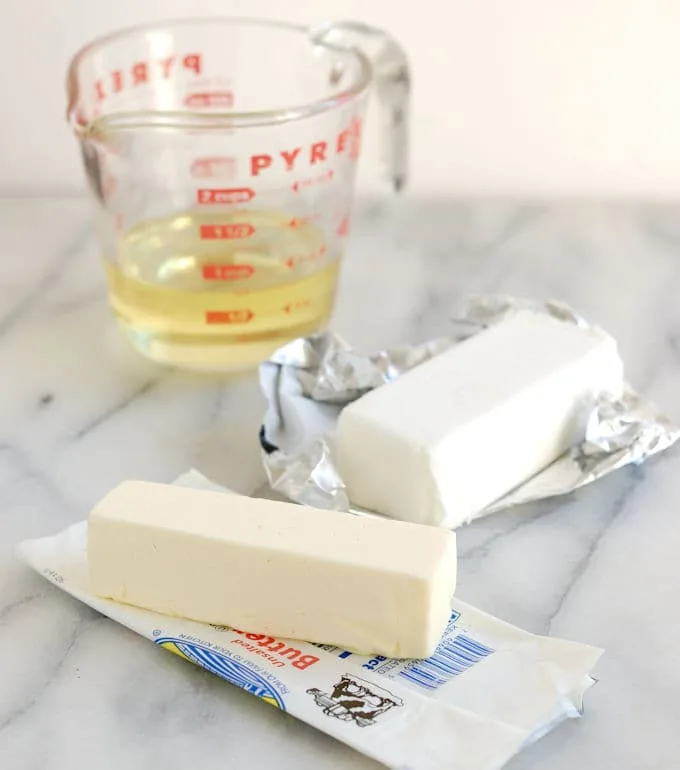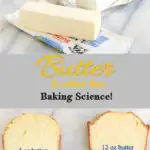The Science of Fats in Baking
Remember the days when fats, especially butter, were villainized? Everywhere you looked you saw “low fat” this and “low fat” that.
Well, no surprise that the pendulum has swung the other way and now everyone loves coconut oil, olive oil and nut oils. Even butter is back in style.

I tend not to sway much with food fads. I’m more in the “everything in moderation” camp. If butter is the best fat to use in a recipe, use butter (unless you’re vegan, read about vegetable shortening below).
The problem with the low fat craze was that to compensate for the lower fat, which meant lower flavor and moisture, extra sugar was added.
Our country got fatter while the “low fat” craze was happening. Now sugar is the villain. Lets see where the pendulum goes next. In the meantime…
Why Baked Goods Need Fat:
Butter and other fats are essential in the baking kitchen. Fat tenderizes and enriches a baked good and fat carries flavor.
There are different fats available to the baker and they each have their own advantages based on what you are making.
Butter as a Baking Ingredient
Don’t we all, basically, know what butter is and how it’s made? If you’ve ever over-whipped cream you’ve seen it.
When heavy cream is agitated (whipping or churning) some of the fat globules in the cream are damaged.
The damaged globules smash into each other and the fat that was released when they were damaged sticks together, gradually forming a mass of butterfat.
The mass separates from the liquid and the liquid is drained off (that’s how buttermilk was originally made). What you’re left with is pure baking gold, beautiful butter!
Butter is about 80% milkfat and 15% water.
It’s made up of some intact globules of butterfat, some solid fat crystals, and some water droplets, all of which are encased in the semisolid fat that was released from the damaged globules.
The semi-solid fat allows butter to be spreadable. As butter warms, some of the liquid fat will be released. That’s why butter softens and becomes more spreadable at room temperature.
That’s also why room temperature butter is best for “creaming” with sugar to form the base of cake batter and cookies.
I always use unsalted butter for baking so I can control how much salt is in the end product. You can see an example here of how a little salt can make a difference in the texture of a baked good.
Shortening as a Baking Ingredient
Vegetable shortening can also be used for baking. Solid vegetable shortening is a great substitute for vegans since it’s a plant product.
The good news is that the process for making solid vegetable shortening no longer involves the process that creates a “trans fat”. So vegetable shortening is safe to use.
While nothing compares to the flavor of butter, shortening does have one advantage over butter. When shortening is manufactured it’s pumped full of nitrogen bubbles to aerate and whiten the product. That process also adds stabilizing emulsifiers to the shortening.
Because shortening already has some bubbles in it, and because it has stabilizers that hold the bubbles in, shortening will cream up lighter than butter. A cake made with shortening will be very light and tender.
Because shortening also is an emulsifier, you can add more liquid to the batter. More liquid means more sugar which means a more tender and moister cake.
(Margarine doesn’t have the texture or emulsifying advantages of shortening and doesn’t have the flavor advantage of butter. Personally, I never use margarine.)
Vegetable Oil as a Baking Ingredient
Because vegetable oil is a liquid, it coats the flour proteins better than shortening or butter. A baked good made with oil will be more tender than one made with a solid fat.
Because the flour protein is so well coated it will also absorb less moisture from the batter or dough, leaving more available to make a moister crumb.
Using oil can have advantages, but often it’s best used in conjunction with some butter or by lessening the total amount of liquid in the recipe. Also, liquid oil can not be used for “creaming” to create air bubbles.
Chiffon cakes use oil for super moist cake. I also like a good olive oil cake, like my Meyer Lemon Olive Oil Cake.
Adding just a little olive oil to pizza dough gives the crust great flavor, a slightly tender crumb, and crisp exterior.
I often use oil in muffin or pancake batter because it creates a super moist and soft texture.
Fat Substitutes in Baking
If you must keep to a low fat diet for health reasons, it is possible to replace some or all of the fat in a cake recipe with certain fruit purees.
Fruit purees can moisten and tenderize a cake like fat does, but it will not aerate the cake as a solid fat will. Also, fat carries flavor so the flavor may seem more one-dimensional.
Prune, apple, apricot and pear purees can be used to replace some of the fat in a recipe because they have carbohydrates that bind water and prevent gluten formation.
Cakes and muffins made with fruit purees will be tender and moist, but more dense than those made with solid fat. If you’ve ever made an applesauce cake you know what I mean.


Thanks
Hi, Eileen,
For the last couple of years I didn’t use margarine or shortening in the batter or dough considering it unhealthy stuff.
I see lately on many blogs that people use shortening in the fillings and it puzzles me. I keep thinking how anybody can it shortening instead of butter or mixed with butter in the cake and pastry’s filling and fee their family and clients?
What do you think of the use of shortening in the cake filling?
Well, shortening used to be a “trans fat” which is very unhealthy. But now most of the vegetable shortenings are no longer “partially hydrogenated” so are safer to eat. I almost always prefer the flavor of butter, but shortening is a good substitute for folks who are vegan or may have dairy allergies.
Eileen, I appreciate your fine research. I was reading yesterday where a woman replaces mayo as her fat, especially in her white cake ( since mayo is white ) I wondered if you had tested that and had any thoughts on results in flavor , texture and moistness?
Mayonnaise cake recipes have been around for quite some time. I haven’t done much experimenting with replacing fat directly with mayo. True mayonnaise is made with egg yolks and oil so I could see how it works as a cake ingredient. But I’m not sure if it would reduce the total fat since it is made with oil and yolks. I believe “low fat” mayo contains lots of water and some starch to thicken. So using low-fat mayo could reduce the fat in the recipe, but would definitely change the texture.
Thank you so much.found this post really helpful.
Thanks!
Hi! I love your website since I found so many answers to my questions regarding baking. You mentioned in the article, that it would be possible to replace some fat by certain fruit purees. I want to bake a raspberry cake and work with raspberry puree. Do you know how that would react? Would you recommend to reduce some of the fat in the batter when baking with raspberry puree?
Hi Vera, I know for sure that prune, apple, apricot and pear purees can replace some of the fat in a recipe. I’m not sure about raspberry, but my guess is that it wouldn’t work the same as those other purees. Do you want to use raspberry puree in the cake for color or for flavor? Are you specifically trying to reduce the fat? The other possibility would be to use the raspberry puree to replace some of the liquid in the recipe.